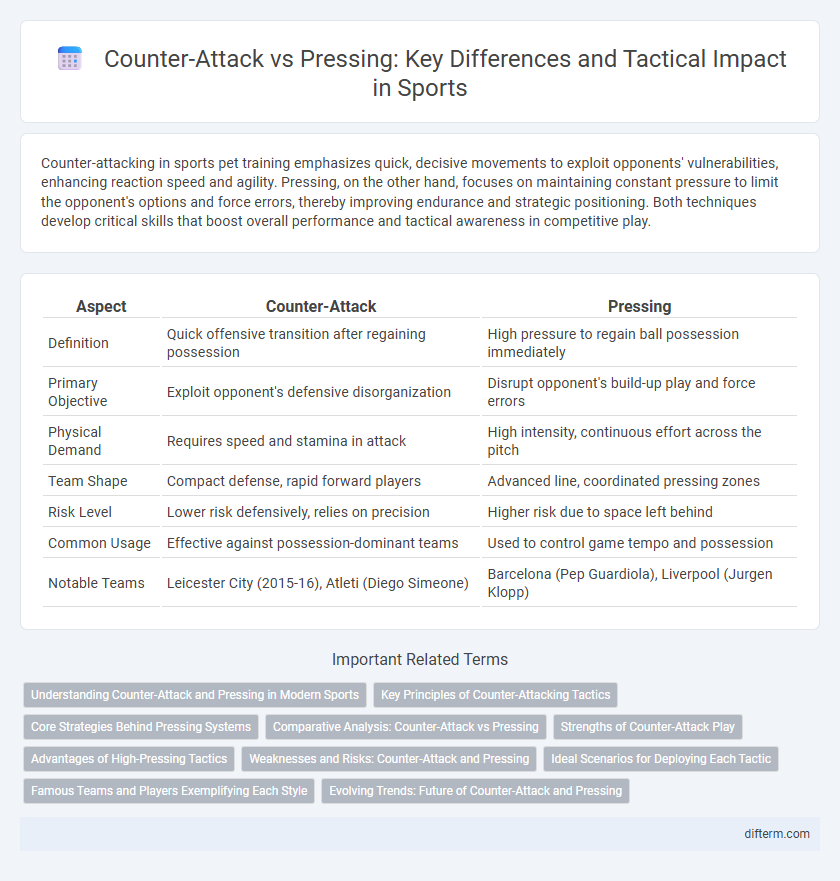Counter-attacking in sports pet training emphasizes quick, decisive movements to exploit opponents' vulnerabilities, enhancing reaction speed and agility. Pressing, on the other hand, focuses on maintaining constant pressure to limit the opponent's options and force errors, thereby improving endurance and strategic positioning. Both techniques develop critical skills that boost overall performance and tactical awareness in competitive play.
Table of Comparison
| Aspect | Counter-Attack | Pressing |
|---|---|---|
| Definition | Quick offensive transition after regaining possession | High pressure to regain ball possession immediately |
| Primary Objective | Exploit opponent's defensive disorganization | Disrupt opponent's build-up play and force errors |
| Physical Demand | Requires speed and stamina in attack | High intensity, continuous effort across the pitch |
| Team Shape | Compact defense, rapid forward players | Advanced line, coordinated pressing zones |
| Risk Level | Lower risk defensively, relies on precision | Higher risk due to space left behind |
| Common Usage | Effective against possession-dominant teams | Used to control game tempo and possession |
| Notable Teams | Leicester City (2015-16), Atleti (Diego Simeone) | Barcelona (Pep Guardiola), Liverpool (Jurgen Klopp) |
Understanding Counter-Attack and Pressing in Modern Sports
Counter-attack in modern sports exploits quick transitions from defense to offense, leveraging speed and precise passing to catch opponents off guard. Pressing involves coordinated, high-intensity pressure to regain possession rapidly, disrupting the opposing team's buildup. Mastery of both tactics requires strategic timing and player positioning to optimize team performance and control the game's tempo.
Key Principles of Counter-Attacking Tactics
Counter-attacking tactics rely on rapid transitions from defense to offense, exploiting opponents' high pressing by quickly advancing the ball into space behind their lines. Key principles include maintaining disciplined defensive organization, swift and precise ball movement, and exploiting numerical advantages in open areas. Successful counter-attacks maximize speed and width, often involving long passes and fast wingers to outpace defenders and create scoring opportunities.
Core Strategies Behind Pressing Systems
Pressing systems in sports emphasize quick recovery of the ball through coordinated team pressure, disrupting opponents' play and forcing errors in their defensive structure. This strategy relies on spatial awareness, communication, and stamina to maintain high-intensity pressure, enabling players to regain possession and launch effective counter-attacks. Core pressing principles include positional compactness, anticipation of opponents' moves, and synchronized pressing triggers to maximize defensive efficiency.
Comparative Analysis: Counter-Attack vs Pressing
Counter-attack strategies exploit opponents' defensive gaps by swiftly transitioning from defense to offense, maximizing space and speed to create high-quality scoring opportunities. Pressing emphasizes aggressive, high-intensity defense aimed at regaining possession quickly, disrupting the opponent's build-up play and minimizing their time on the ball. While counter-attacking relies on quick, calculated breaks, pressing demands continuous physical exertion and coordination to maintain pressure, shaping distinct tactical dynamics and game rhythms.
Strengths of Counter-Attack Play
Counter-attack play maximizes speed and precision, exploiting the opponent's momentary disorganization during pressing transitions. It leverages quick ball recovery to launch rapid offensive moves, often catching opponents off-guard and creating high-quality scoring opportunities. This strategy efficiently utilizes space behind an advanced pressing defense, turning defensive situations into potent attacking threats.
Advantages of High-Pressing Tactics
High-pressing tactics disrupt the opponent's build-up play, forcing turnovers in dangerous areas and creating immediate scoring opportunities. This proactive defensive strategy limits the opposition's time on the ball, leading to higher interception rates and increased control over the game's tempo. Teams employing high-pressing consistently apply intense pressure, which can fatigue opponents and exploit defensive vulnerabilities effectively.
Weaknesses and Risks: Counter-Attack and Pressing
Counter-attacking in sports risks exposing a team to defensive vulnerabilities if possession is lost during rapid transitions, often leaving defenders outnumbered. Pressing demands high physical exertion and coordination, increasing the likelihood of tactical disorganization and susceptibility to quick passes that bypass the press. Both strategies can be exploited by opponents who anticipate these patterns, emphasizing the need for adaptive tactical discipline.
Ideal Scenarios for Deploying Each Tactic
Counter-attack is most effective against teams that dominate possession but leave spaces behind their defense, allowing quick transitions to exploit gaps with fast attackers. Pressing thrives in scenarios where disrupting the opponent's buildup is crucial, especially when facing teams with weaker technical skills or slower decision-making under pressure. Teams with high stamina and tactical discipline typically excel in pressing, while those with pace and precision passing benefit from counter-attacking strategies.
Famous Teams and Players Exemplifying Each Style
Barcelona's tiki-taka style under Pep Guardiola epitomized pressing, with players like Xavi and Iniesta relentlessly winning back possession high up the pitch. In contrast, Real Madrid's counter-attack strategy, especially during the Cristiano Ronaldo era, showcased rapid transitions exploiting spaces left by opponents. Both styles, embodied by these iconic teams and players, highlight contrasting yet effective approaches in modern football tactics.
Evolving Trends: Future of Counter-Attack and Pressing
Counter-attacking and pressing have evolved with modern football's emphasis on speed, space exploitation, and tactical flexibility. Advanced metrics highlight how teams using high-press strategies force turnovers to launch rapid counter-attacks, blending both approaches for optimized performance. Emerging trends suggest integration of AI-driven analysis to predict opponent pressing patterns, enhancing counter-attack efficiency in future match tactics.
counter-attack vs pressing Infographic

 difterm.com
difterm.com